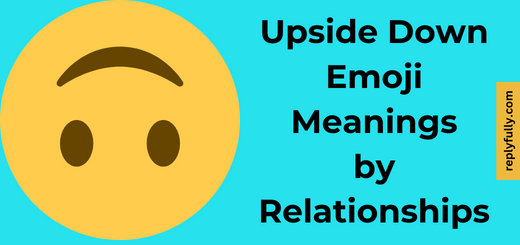The upside down smiley face emoji 🙃 is meant to convey sarcasm, irony or that something is wrong. Unlike the regular smiley face which represents happiness, the upside down version implies an opposite, unhappy or unpleasant mood.
However, its exact meaning depends greatly on the context and relationship between the people communicating.
Upside Down Emoji Meaning by relationships
Upside down emoji meaning from a boy to a girl
When used between boys and girls who are friends, the upside down emoji typically means something has gone wrong in their interaction like teasing, joking or playful criticism. It softens potentially hurtful comments and shows the message is not meant seriously or maliciously.
In the context of dating and relationships between boys and girls, the upside down emoji suggests disappointment, annoyance or anger at something the other person did or said. It questions their actions in a subtle, implied way without being too direct or confrontational.
Example Usage:
Boy: Sorry I missed our plans, something came up 🙃
Girl: Sure it did 🙃
Girl: We’re really not talking again? 🙃
Boy: I don’t know what you want from me 🙃
Upside down emoji meaning between girls
Girl friends often use the upside down emoji as a joking, sarcastic response to something dramatic or weird the other person shared. It lightens serious topics and bonds them through shared understandings without words.
If used between girls who are fighting, the upside down emoji may represent passive-aggressiveness, hidden resentment or that the issue is still unresolved between them despite appearing fine on the surface. This meaning requires awareness of the context and dynamics of their friendship.
Example Usage:
Girl 1: “Remember that time we pulled off that prank? 🙃”
Girl 2: “Yes! We were unstoppable!”
Upside down emoji meaning between boys
Among male friends, the upside down emoji commonly implies criticism or mocking related to something perceived as ridiculous or unmanly that was said or done. It maintains humor in potentially tense exchanges.
In more serious disagreement between boys, the upside smiley conveys anger, irritation or blaming the other party non-directly for what went wrong. The subtext is to get their point across argumentatively without outright saying it.
Example Usage:
Boy 1: “I bet I can beat you in the game tonight 🙃”
Boy 2: “Bring it on! Let’s see who’s the real champion!”
Upside down emoji meaning within families
In a familial context between parents and children or among siblings, the upside down emoji softens complaints, dissatisfaction or harsher comments. It spares hurt feelings and allows conversations to continue respectfully even when opinions differ.
It can also call attention jokingly to inappropriate, gross or immature behaviors without directly scolding the person, especially in adolescent interactions or between siblings who tease each other. The implied message comes across playfully.
Example Usage:
Brother: You ate all the cookies again?! 🙃
Sister: Finders keepers 🙃
Sister: Stop leaving your dirty laundry everywhere 🙃
Brother: Chill it was just this once 🙃
Upside down emoji meaning between colleagues
At work, the upside down emoji helps disagree on issues politely or point out errors subtly without causing escalating tensions. It maintains working relationships through indirect language when saying things directly could impact someone’s job or performance review negatively.
Among peer colleagues, the upside down smiley acts similarly to build understanding and prevent microaggressions from accumulating into bigger conflicts over time. It expresses perspectives diplomatically for productive outcomes.
Example Usage:
Colleague 1: Did you finish the reports I sent? 🙃
Colleague 2: Almost there, just need a bit more time 🙃
Manager: Another mistake on this project 🙃
Employee: Won’t happen again, my bad 🙃
Combining Upside down emoji with other emojis
The upside down emoji pairs well with various emojis to change or strengthen the implied meaning and sarcasm depending on context. Here are some examples:
| Combination emoji | Meaning | Example usage |
|---|---|---|
| 😂 | Sarcastic laughter at an attempt at humor that missed the mark | That joke was so funny I forgot to laugh 🙃😂 |
| 😒 | Exasperation and frustration over a situation | Here we go again 🙃😒 |
| 🤦 | Facepalm at one’s own mistake or foolish action | I can’t believe I did that 🙃🤦 |
| 🙄 | Eye roll at something believed to be trivial or unnecessary | Do we really have to do this? 🙃🙄 |
| Puzzled shrug over an unclear or imperfect outcome | Well that was…something 🙃🤷 | |
| 😬 | Cringe at secondhand embarrassment | Yikes, I felt that just watching 🙃😬 |
| 👀 | Side eyes suggesting sly judgment of another’s actions | Mhm… 🙃👀 sure Jan |
| 😩 | Heavy sigh at difficulty of a tiresome task | Ugh not this again 🙃😩 |
| 🥴 | Loopy smile implying being intoxicated or dazed | I may have had one too many 🙃🥴 |
The combinations open up new nuanced meanings through interactive visual storytelling rather than words alone. Understanding context remains key to deciphering implied messages.
Conclusion
In summary, the upside down smiley face emoji is a versatile tool for subtle, implied communication that depends greatly on relationships and situation context. On its own, it questions or criticizes in a sarcastic tone without aggression. Combined creatively with other emojis, even more complex implied meanings and humor can be expressed visually for connection.

